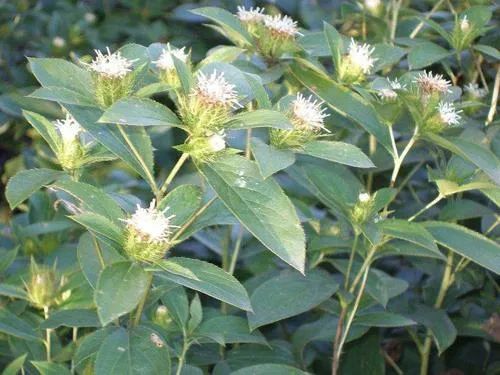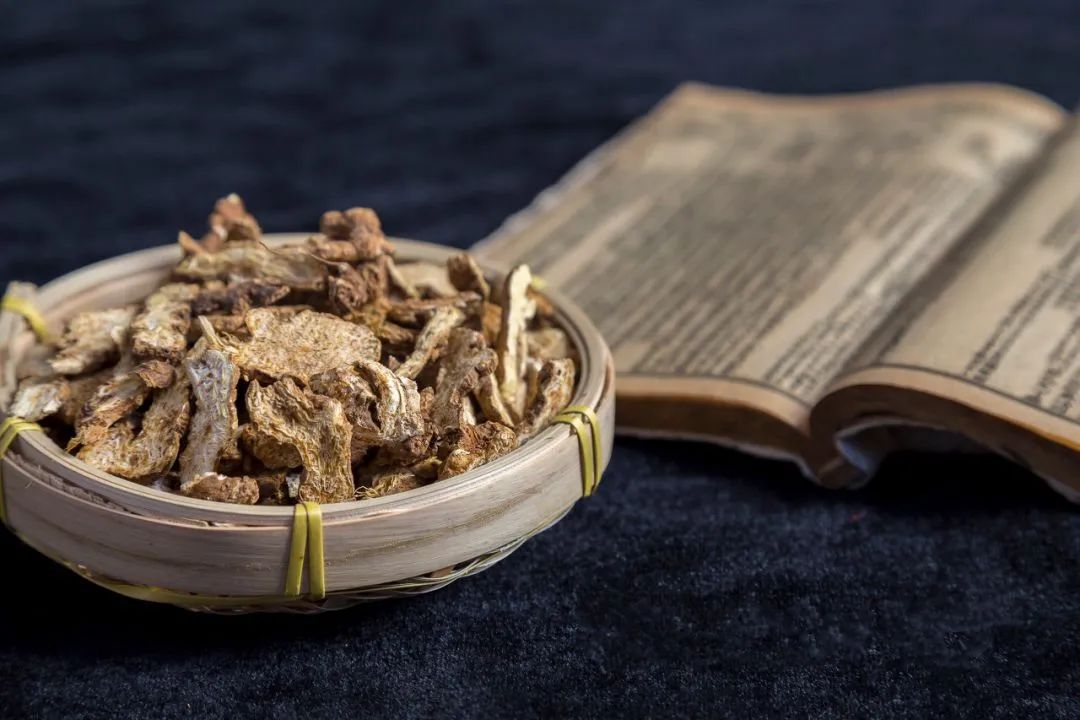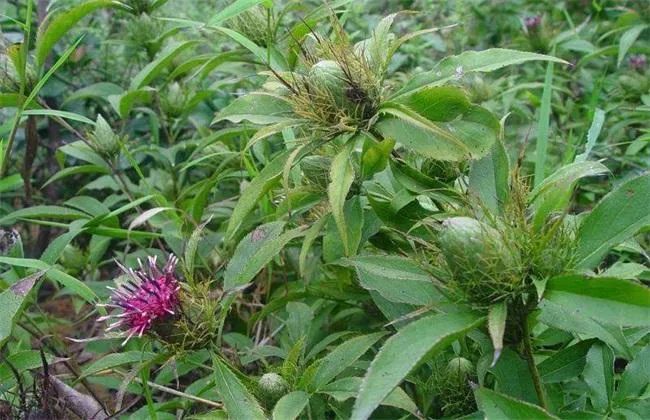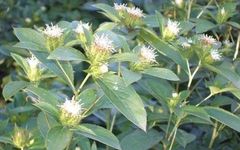Click the top left ↑ “Daoist Physician Chen Ming” to follow the public account

Atractylodes (Cang Zhu)

Atractylodes (Scientific name: Atractylodes lancea (Thunb.) DC.): A perennial herb of the Asteraceae family. The rhizome is horizontal or obliquely ascending, with adventitious roots. The stem is erect, reaching up to 100 cm, solitary or clustered in small numbers, with the basal leaves falling off during flowering; the middle and lower stem leaves are nearly sessile, round, obovate, oblique ovate, ovate, or elliptical, while the upper stem leaves are undivided, oblong-ovate, obovate, or long-ovate. All leaves are thick and papery, green on both sides, hairless, with spiny margins or triangular serrations. The head-like flower clusters are solitary at the top of the stem, with a bell-shaped involucre, and the involucral bracts are spiny and deeply lobed. The small flowers are white, and the achenes are obovate, covered with dense, straight, white hairs. The pappus is brown or dirty white, flowering and fruiting from June to October.
The rhizome of Atractylodes is used medicinally, acting as a spleen-strengthening herb, with a bitter, warm, and pungent flavor, effective in drying dampness, transforming turbidity, and alleviating pain. This species has many commercial names, such as Han Cang Zhu and Miao Zhu (Miao Atractylodes); however, these names can generally be divided into two main categories: Northern Atractylodes and Southern Atractylodes.
01Source
The rhizome of the Asteraceae plant Atractylodes.
02Alias
Southern Atractylodes, Miao Zhu, Mountain Essence, Red Atractylodes, Immortal Atractylodes.
03Plant Morphology
Perennial herb, 30-80 cm tall. The rhizome runs horizontally, nodular, thick, and irregular. The stem is erect and woody at the base. Leaves are alternate, leathery, with upper leaves generally undivided and sessile, ovate-lanceolate to elliptical, with spiny serrations on the edges. The lower leaves are often 3-5 deeply lobed or partially lobed, with the central lobe larger, round or obovate, and the lateral lobes smaller, with or without petioles. The head-like flower clusters are terminal, with one whorl of leaf-like bracts, deeply lobed and spiny; the involucre has 6-8 layers, ovate to lanceolate; there are many flowers, bisexual or unisexual and dioecious; all are tubular flowers with numerous feathery long pappus, and the corolla is white; the bisexual flowers have 5 stamens, and the ovary is densely covered with white soft hairs; unisexual flowers are generally female, with 5 degenerated stamens. The achenes are covered with white soft hairs, and the feathery pappus is about 0.8 cm long. Flowering occurs from August to October, and fruiting from September to October.
04Distribution
Commonly found in shrublands and grasslands on hillsides. Distributed in Henan, Shandong, and other regions.

05Harvesting and Processing
Harvest in spring and autumn, remove soil and sand, dry, and remove the fibrous roots.
06Characteristics of the Medicinal Material
Irregularly bead-like or nodular cylindrical, slightly curved, occasionally branched, 3-10 cm long, 1-2 cm in diameter. The surface is gray-brown, with wrinkles, transverse grooves, and residual fibrous roots, with the top having stem scars or residual stem bases. The texture is solid, with a cross-section that is yellow-white or gray-white, scattered with numerous orange-yellow or reddish-brown oil chambers, which can produce white needle-like crystals upon prolonged exposure. The aroma is distinctive, with a slightly sweet, pungent, and bitter taste.
07Nature and Taste
Warm in nature, with a pungent and bitter taste. It enters the Spleen, Stomach, and Liver meridians.
08Functions and Indications
Dries dampness, strengthens the spleen, dispels wind and cold, and improves vision. It belongs to the category of dampness-transforming herbs.
09Clinical Applications
Dosage: 3-10 grams, decocted in water for oral administration. Used to treat abdominal distension, diarrhea, edema, beriberi, rheumatic pain, wind-cold common cold, and night blindness.
10Pharmacological Research
Anti-gastritis, anti-gastric ulcer; regulates gastrointestinal motility; protects the liver from damage; anti-hypoxia; has a blocking effect on nicotinic receptors. The decoction can counteract experimental gastritis and gastric ulcers, significantly inhibiting gastric juice volume, acidity, and pepsin activity. Serum ulcers are caused by ischemia and circulatory disorders of the gastric mucosa, and Atractylodes has a significant effect on this. It also has pharmacological effects such as liver protection, bile excretion, and anti-hypoxia.

11Chemical Composition
This product contains atractylon, 2-alkene, atractylodes lactone, patchouli alcohol, elemol, acetyl atractylon, and dehydro atractylon ester. It also contains volatile oils, with the main components being atractylon ketone, atractylon alkyne, and atractylon spiron.
12Contraindications
Should not be taken in excess. Avoid taking with sour foods. Contraindicated in pregnant women.
13
Compatible Formulas
1. For dampness-related body pain: Atractylodes, soaked in rice wash, cut, decocted to extract a concentrated syrup. Take with white soup. (From “Simple Formulas”)
2. For joint pain due to damp-heat: Huang Bai (fried), Atractylodes (soaked in rice wash and fried). Grind these two into a fine powder, and mix with ginger juice in boiling soup for administration. Both herbs have a strong effect; for those with a solid exterior, add a little wine to assist.
3. For diarrhea: 60 grams of Atractylodes, 30 grams of small pepper (remove seeds, fry). Grind into a very fine powder, mix with vinegar to form pills the size of a wutong seed. Take thirty pills with warm water before meals. (From “Preserving Life Collection” Pepper Atractylodes Pills)
4. For summer heat-related diarrhea, strengthen the spleen and warm the stomach, consume ginger in food, and treat dietary injuries, chest and abdominal distension: Shen Qu (fried), Atractylodes (soaked in rice wash overnight, dried) in equal parts, ground into powder. Form into pills the size of a wutong seed. Take thirty pills at any time, swallowed with rice drink. (From “Prescriptions”)
5. To nourish deficiency, improve vision, strengthen bones, and harmonize blood: Atractylodes (soaked) 120 grams, cooked Rehmannia (baked) 60 grams. Grind into powder, form into pills the size of a wutong seed. Take three to fifty pills with warm wine, three times a day. (From “Universal Prescriptions”)

(Thank you for reading, please share this article with more friends to help everyone stay away from diseases!!!)

This graphic and text video comes from the internet, shared for informational purposes. If there is any infringement, please notify for removal.

